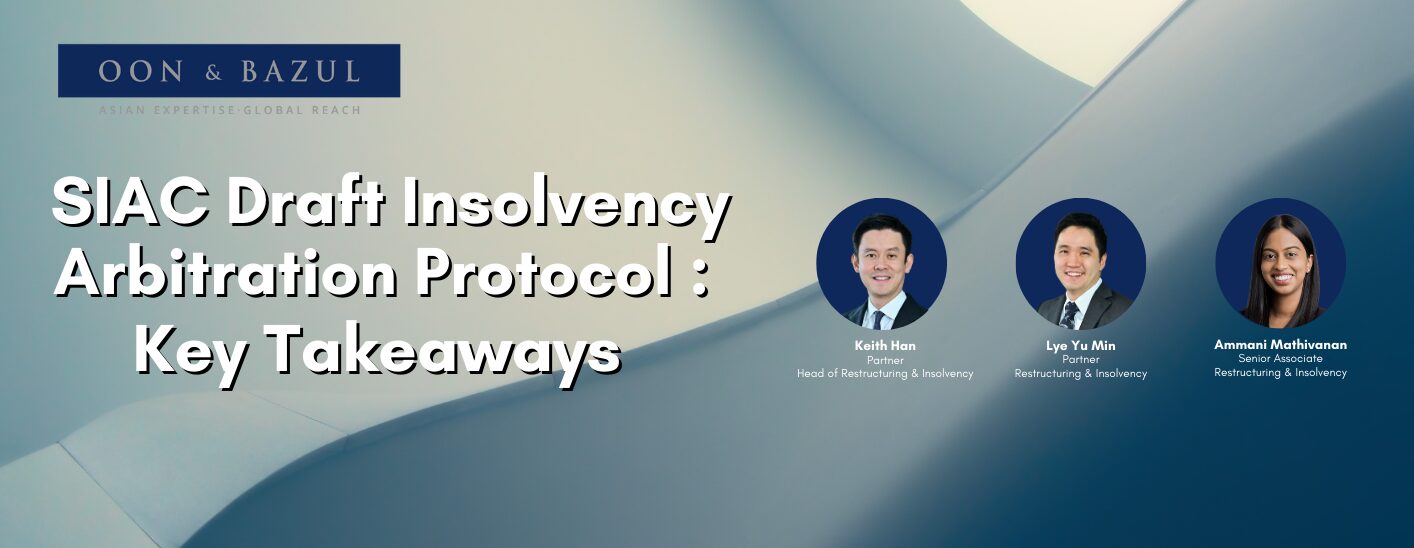SIAC Draft Insolvency Arbitration Protocol : Key Takeaways
Introduction
- Along with the coming into force of the 7th Edition of the Singapore International Arbitration (“SIAC”) Rules (which our colleagues have discussed in a previous article), the new SIAC Rules was also accompanied with the release of a draft Insolvency Arbitration Protocol (“the Protocol”) for public consultation.
- Designed to address disputes arising from or in anticipation of insolvency proceedings, the Protocol adapts SIAC Rules to provide a structured, efficient, and time-sensitive framework for arbitration in insolvency contexts.
- According to SIAC, the Protocol is a first for an international arbitration institution in proposing the use of arbitration for the resolution of insolvency-related disputes and claims. This article will cover the key features of the Protocol in contrast with the regular SIAC Rules as well as new measures introduced to achieve efficiency in the insolvency dispute context.
Modification to timelines
- In light of the urgent and time-sensitive nature of insolvency proceedings, the Protocol modifies certain procedural timelines set out in the original SIAC Rule:
| Procedural Requirement | SIAC Rules | Protocol |
|---|---|---|
| Response to notice of arbitration | Within 14 days from the date of commencement of the arbitration (“Commencement Date”) | Within 7 days from the Commencement Date |
| Joint nomination of the sole arbitrator | Within 21 days from the Commencement Date | Within 14 days from the Commencement Date |
| Notice of challenge to arbitrator | Within 15 days from the notice of appointment of arbitrator | Within 3 days from the notice of appointment of arbitrator |
| Issuance of final award | Within 6 months from the constitution of the tribunal (similar to deadline prescribed under an Expedited Procedure) | No deadline prescribed under the general procedure |
| Submission of draft award to the Registrar | Within 90 days from the last directed written or oral submission | Within 30 days from the last directed written or oral submission |
Other notable features
- Aside from modifications to procedural timelines, the Protocol makes other structural modifications and additions. For example, the Protocol provides that the default seat of arbitration and governing law of the arbitration agreement shall be Singapore and Singapore law respectively (unless it is otherwise agreed by the parties or determined by the tribunal). In contrast, the SIAC Rules leave the seat of arbitration to be determined by parties’ agreement or by tribunal and the governing law of the arbitration agreement is left unspecified (usually determined by an application of conflict of laws rules).
- The Protocol also provides that a sole arbitrator shall be appointed to any arbitration unless the Registrar determines, after considering the views of the parties, the complexity, the quantum involved, or other relevant circumstances of the dispute, that three arbitrators ought to be appointed. Furthermore, the Protocol seeks to develop a SIAC Specialist Insolvency Disputes Panel. The Protocol provides that arbitrators under the Protocol may be sourced and appointed from the above panel.
- Moreover, the Protocol provides a specific cue to arbitrators and parties to consider mediation to resolve any disputes that are brought to arbitration. This is intended to promote the use of mediation in the context of insolvency-related disputes even within the confines of an arbitration process. This specific cue comes in the form of the appointed tribunal’s power to suspend arbitration proceedings for a period of 3 weeks to allow parties to attempt mediation, and the ability of parties to secure a consent award from the tribunal following a successful mediated settlement agreement, if they wish to do so.
Takeaways
- As noted by Report of the Committee to Strengthen Singapore as an International Centre for Debt Restructuring[1] (“the Report”), the use of alternative dispute resolution mechanisms such as arbitration could be useful in disputes involving cross-border issues as arbitration would prevent issues from being re-litigated across various jurisdictions. It would also be useful in complex cases (e.g. disputes involving highly complex financial instruments) where there may be a need for specialist knowledge in the subject area and where it is likely that there will be inconsistent court decisions.
- The renewed emphasis on mediation also seems to be motivated by empirical findings regarding its effectiveness. As noted by the Report, mediation was used in the majority of Chapter 11 proceedings in the US involving debtors with assets over $1 billion between 2000 and 2011. The Report also notes that the increased use of mediation in the US appears to be driven by the bankruptcy courts and bankruptcy judges, who play a leading role in encouraging parties to undergo mediation and other alternative dispute resolution processes.
- Given that global corporate defaults have hit their highest levels since the global financial crisis in 2008 and the increasing globalisation of businesses, the Protocol provides a legal framework which combines clarity, efficiency, and expertise in solving insolvency disputes. Overall, this is a step in the right direction in ensuring that Singapore can continue to be a leading centre for international debt restructuring.
This article was authored by Partner and Head of Restructuring & Insolvency (R&I) Practice Keith Han, Partner Lye Yu Min and Senior Associate Ammani Mathivanan.
Our Restructuring & Insolvency lawyers are adept at crafting practical, commercial and cost-effective solutions that few can rival in Singapore and Asia. We are the restructuring and insolvency law firm of choice for multinational companies, distressed and special situations funds, financial institutions and insolvency practitioners, such as judicial managers, scheme managers, chief restructuring officers and liquidators
You may visit our R&I page to learn more about our practice:https://oonbazul.com/restructuring-insolvency/
If you require any legal advice on R&I related matters, please do not hesitate to get in touch with the authors above.
[1] 2016, Ministry of Law



